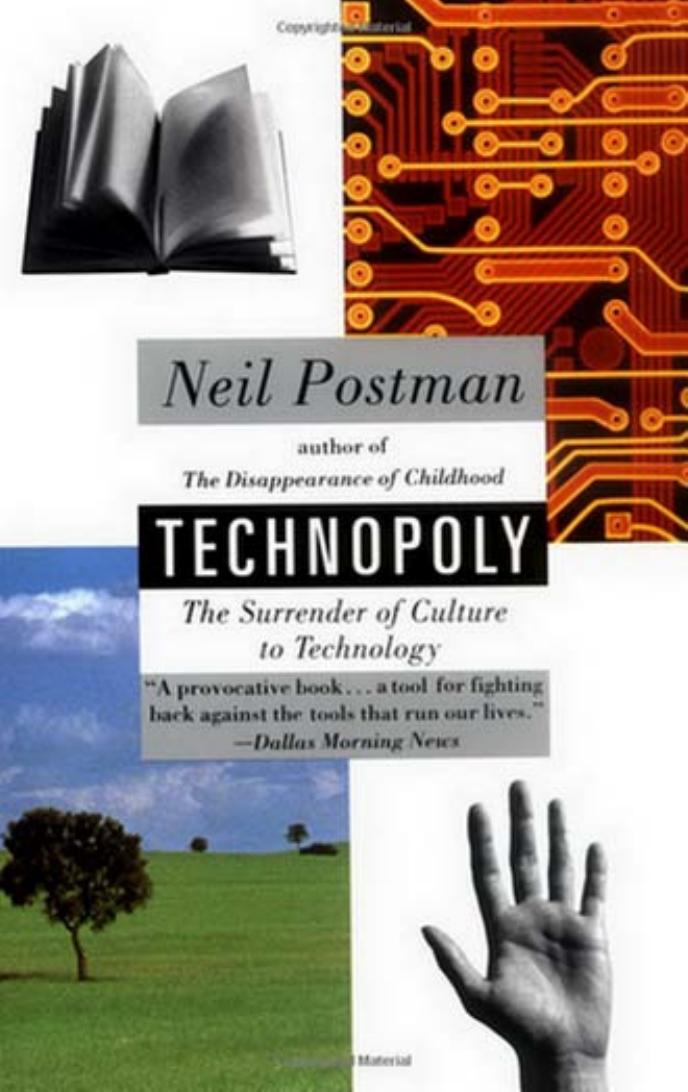Technopoly: The Surrender of Culture to Technology by Neil Postman

Author:Neil Postman [Postman, Neil]
Language: eng
Format: epub, pdf
Tags: Non-Fiction
ISBN: 9780679745402
Google: gYrIVidSiLIC
Amazon: B004ZZJBW4
Published: 1992-03-31T08:00:00+00:00
7
The Ideology of Machines:
Computer Technology
That American Technopoly has now embraced the computer in the same hurried and mindless way it embraced medical technology is undeniable, was perhaps inevitable, and is certainly most unfortunate. This is not to say that the computer is a blight on the symbolic landscape; only that, like medical technology, it has usurped powers and enforced mind-sets that a fully attentive culture might have wished to deny it. Thus, an examination of the ideas embedded in computer technology is worth attempting. Others, of course, have done this, especially Joseph Weizenbaum in his great and indispensable book Computer Power and Human Reason. Weizenbaum, however, ran into some difficulties, as everyone else has, because of the “universality” of computers, meaning (a) that their uses are infinitely various, and (b) that computers are commonly integrated into the structure of other machines. It is, therefore, hard to isolate specific ideas promoted by computer technology. The computer, for example, is quite unlike the stethoscope, which has a limited function in a limited context. Except for safecrackers, who, I am told, use stethoscopes to hear the tumblers of locks click into place, stethoscopes are used only by doctors. But everyone uses or is used by computers, and for purposes that seem to know no boundaries.
Putting aside such well-known functions as electronic filing, spreadsheets, and word-processing, one can make a fascinating list of the innovative, even bizarre, uses of computers. I have before me a report from The New York Times that tells us how computers are enabling aquatic designers to create giant water slides that mimic roller coasters and eight-foot-high artificial waves.1 In my modest collection, I have another article about the uses of personal computers for making presentations at corporate board meetings.2 Another tells of how computer graphics help jurors to remember testimony better. Gregory Mazares, president of the graphics unit of Litigation Sciences, is quoted as saying, “We’re a switched-on, tuned-in, visually oriented society, and jurors tend to believe what they see. This technology keeps the jury’s attention by simplifying the material and by giving them little bursts of information.” 3 While Mr. Mazares is helping switched-on people to remember things, Morton David, chief executive officer of Franklin Computer, is helping them find any word in the Bible with lightning speed by producing electronic Bibles. (The word “lightning,” by the way, appears forty-two times in the New International version and eight times in the King James version. Were you so inclined, you could discover this for yourself in a matter of seconds.) This fact so dominates Mr. David’s imagination that he is quoted as saying, “Our technology may have made a change as momentous as the Gutenberg invention of movable type.”4 And then there is an article that reports a computer’s use to make investment decisions, which helps you, among other things, to create “what-if” scenarios, although with how much accuracy we are not told.5 In Technology Review, we find a description of how computers are used to help the police
Download
Technopoly: The Surrender of Culture to Technology by Neil Postman.epub
Technopoly: The Surrender of Culture to Technology by Neil Postman.pdf
This site does not store any files on its server. We only index and link to content provided by other sites. Please contact the content providers to delete copyright contents if any and email us, we'll remove relevant links or contents immediately.
| Automotive | Engineering |
| Transportation |
Whiskies Galore by Ian Buxton(41524)
Introduction to Aircraft Design (Cambridge Aerospace Series) by John P. Fielding(32883)
Small Unmanned Fixed-wing Aircraft Design by Andrew J. Keane Andras Sobester James P. Scanlan & András Sóbester & James P. Scanlan(32569)
Craft Beer for the Homebrewer by Michael Agnew(17927)
Turbulence by E. J. Noyes(7690)
The Complete Stick Figure Physics Tutorials by Allen Sarah(7135)
Kaplan MCAT General Chemistry Review by Kaplan(6588)
The Thirst by Nesbo Jo(6432)
Bad Blood by John Carreyrou(6270)
Modelling of Convective Heat and Mass Transfer in Rotating Flows by Igor V. Shevchuk(6219)
Learning SQL by Alan Beaulieu(6029)
Weapons of Math Destruction by Cathy O'Neil(5820)
Man-made Catastrophes and Risk Information Concealment by Dmitry Chernov & Didier Sornette(5641)
Digital Minimalism by Cal Newport;(5384)
Life 3.0: Being Human in the Age of Artificial Intelligence by Tegmark Max(5181)
iGen by Jean M. Twenge(5151)
Secrets of Antigravity Propulsion: Tesla, UFOs, and Classified Aerospace Technology by Ph.D. Paul A. Laviolette(4974)
Design of Trajectory Optimization Approach for Space Maneuver Vehicle Skip Entry Problems by Runqi Chai & Al Savvaris & Antonios Tsourdos & Senchun Chai(4837)
Electronic Devices & Circuits by Jacob Millman & Christos C. Halkias(4739)
